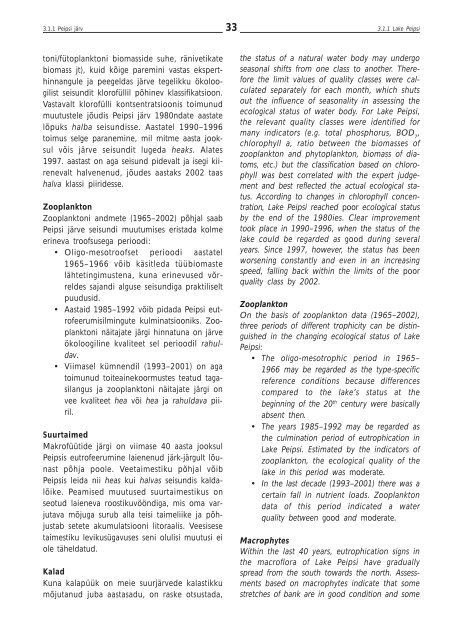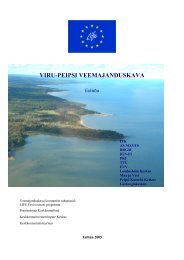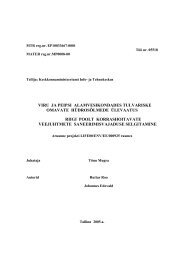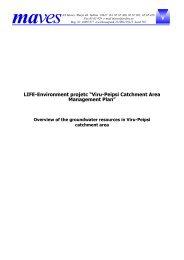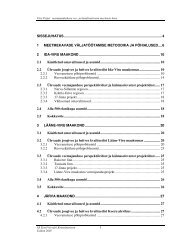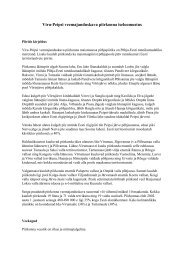Viru-Peipsi veemajanduskava - Keskkonnaministeerium
Viru-Peipsi veemajanduskava - Keskkonnaministeerium
Viru-Peipsi veemajanduskava - Keskkonnaministeerium
Create successful ePaper yourself
Turn your PDF publications into a flip-book with our unique Google optimized e-Paper software.
3.1.1 <strong>Peipsi</strong> järv<br />
33<br />
3.1.1 Lake <strong>Peipsi</strong><br />
toni/fütoplanktoni biomasside suhe, ränivetikate<br />
biomass jt), kuid kõige paremini vastas eksperthinnangule<br />
ja peegeldas järve tegelikku ökoloogilist<br />
seisundit klorofüllil põhinev klassifikatsioon.<br />
Vastavalt klorofülli kontsentratsioonis toimunud<br />
muutustele jõudis <strong>Peipsi</strong> järv 1980ndate aastate<br />
lõpuks halba seisundisse. Aastatel 1990–1996<br />
toimus selge paranemine, mil mitme aasta jooksul<br />
võis järve seisundit lugeda heaks. Alates<br />
1997. aastast on aga seisund pidevalt ja isegi kiirenevalt<br />
halvenenud, jõudes aastaks 2002 taas<br />
halva klassi piiridesse.<br />
Zooplankton<br />
Zooplanktoni andmete (1965–2002) põhjal saab<br />
<strong>Peipsi</strong> järve seisundi muutumises eristada kolme<br />
erineva troofsusega perioodi:<br />
• Oligo-mesotroofset perioodi aastatel<br />
1965–1966 võib käsitleda tüübiomaste<br />
lähtetingimustena, kuna erinevused võrreldes<br />
sajandi alguse seisundiga praktiliselt<br />
puudusid.<br />
• Aastaid 1985–1992 võib pidada <strong>Peipsi</strong> eutrofeerumisilmingute<br />
kulminatsiooniks. Zooplanktoni<br />
näitajate järgi hinnatuna on järve<br />
ökoloogiline kvaliteet sel perioodil rahuldav.<br />
• Viimasel kümnendil (1993–2001) on aga<br />
toimunud toiteainekoormustes teatud tagasilangus<br />
ja zooplanktoni näitajate järgi on<br />
vee kvaliteet hea või hea ja rahuldava piiril.<br />
Suurtaimed<br />
Makrofüütide järgi on viimase 40 aasta jooksul<br />
<strong>Peipsi</strong>s eutrofeerumine laienenud järk-järgult lõunast<br />
põhja poole. Veetaimestiku põhjal võib<br />
<strong>Peipsi</strong>s leida nii heas kui halvas seisundis kaldalõike.<br />
Peamised muutused suurtaimestikus on<br />
seotud laieneva roostikuvööndiga, mis oma varjutava<br />
mõjuga surub alla teisi taimeliike ja põhjustab<br />
setete akumulatsiooni litoraalis. Veesisese<br />
taimestiku levikusügavuses seni olulisi muutusi ei<br />
ole täheldatud.<br />
Kalad<br />
Kuna kalapüük on meie suurjärvede kalastikku<br />
mõjutanud juba aastasadu, on raske otsustada,<br />
the status of a natural water body may undergo<br />
seasonal shifts from one class to another. Therefore<br />
the limit values of quality classes were calculated<br />
separately for each month, which shuts<br />
out the influence of seasonality in assessing the<br />
ecological status of water body. For Lake <strong>Peipsi</strong>,<br />
the relevant quality classes were identified for<br />
many indicators (e.g. total phosphorus, BOD 7<br />
,<br />
chlorophyll a, ratio between the biomasses of<br />
zooplankton and phytoplankton, biomass of diatoms,<br />
etc.) but the classification based on chlorophyll<br />
was best correlated with the expert judgement<br />
and best reflected the actual ecological status.<br />
According to changes in chlorophyll concentration,<br />
Lake <strong>Peipsi</strong> reached poor ecological status<br />
by the end of the 1980ies. Clear improvement<br />
took place in 1990–1996, when the status of the<br />
lake could be regarded as good during several<br />
years. Since 1997, however, the status has been<br />
worsening constantly and even in an increasing<br />
speed, falling back within the limits of the poor<br />
quality class by 2002.<br />
Zooplankton<br />
On the basis of zooplankton data (1965–2002),<br />
three periods of different trophicity can be distinguished<br />
in the changing ecological status of Lake<br />
<strong>Peipsi</strong>:<br />
• The oligo-mesotrophic period in 1965–<br />
1966 may be regarded as the type-specific<br />
reference conditions because differences<br />
compared to the lake’s status at the<br />
beginning of the 20 th century were basically<br />
absent then.<br />
• The years 1985–1992 may be regarded as<br />
the culmination period of eutrophication in<br />
Lake <strong>Peipsi</strong>. Estimated by the indicators of<br />
zooplankton, the ecological quality of the<br />
lake in this period was moderate.<br />
• In the last decade (1993–2001) there was a<br />
certain fall in nutrient loads. Zooplankton<br />
data of this period indicated a water<br />
quality between good and moderate.<br />
Macrophytes<br />
Within the last 40 years, eutrophication signs in<br />
the macroflora of Lake <strong>Peipsi</strong> have gradually<br />
spread from the south towards the north. Assessments<br />
based on macrophytes indicate that some<br />
stretches of bank are in good condition and some


